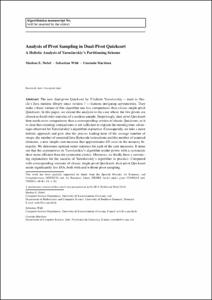Mostra el registre d'ítem simple
Analysis of pivot sampling in dual-pivot Quicksort: A holistic analysis of Yaroslavskiy's partitioning scheme
| dc.contributor.author | Nebel, Markus E. |
| dc.contributor.author | Wild, Sebastian |
| dc.contributor.author | Martínez Parra, Conrado |
| dc.contributor.other | Universitat Politècnica de Catalunya. Departament de Ciències de la Computació |
| dc.date.accessioned | 2016-09-14T07:49:06Z |
| dc.date.available | 2016-09-14T07:49:06Z |
| dc.date.issued | 2016-08 |
| dc.identifier.citation | Nebel, M., Wild, S., Martínez, C. Analysis of pivot sampling in dual-pivot Quicksort: A holistic analysis of Yaroslavskiy's partitioning scheme. "Algorithmica", Agost 2016, vol. 75, núm. 4, p. 632-683. |
| dc.identifier.issn | 0178-4617 |
| dc.identifier.uri | http://hdl.handle.net/2117/89895 |
| dc.description | The final publication is available at Springer via http://dx.doi.org/10.1007/s00453-015-0041-7 |
| dc.description.abstract | The new dual-pivot Quicksort by Vladimir Yaroslavskiy-used in Oracle's Java runtime library since version 7-features intriguing asymmetries. They make a basic variant of this algorithm use less comparisons than classic single-pivot Quicksort. In this paper, we extend the analysis to the case where the two pivots are chosen as fixed order statistics of a random sample. Surprisingly, dual-pivot Quicksort then needs more comparisons than a corresponding version of classic Quicksort, so it is clear that counting comparisons is not sufficient to explain the running time advantages observed for Yaroslavskiy's algorithm in practice. Consequently, we take a more holistic approach and give also the precise leading term of the average number of swaps, the number of executed Java Bytecode instructions and the number of scanned elements, a new simple cost measure that approximates I/O costs in the memory hierarchy. We determine optimal order statistics for each of the cost measures. It turns out that the asymmetries in Yaroslavskiy's algorithm render pivots with a systematic skew more efficient than the symmetric choice. Moreover, we finally have a convincing explanation for the success of Yaroslavskiy's algorithm in practice: compared with corresponding versions of classic single-pivot Quicksort, dual-pivot Quicksort needs significantly less I/Os, both with and without pivot sampling. |
| dc.format.extent | 52 p. |
| dc.language.iso | eng |
| dc.subject | Àrees temàtiques de la UPC::Informàtica::Informàtica teòrica |
| dc.subject.lcsh | Algorithms |
| dc.subject.other | Quicksort |
| dc.subject.other | Dual-pivot |
| dc.subject.other | Yaroslavskiy's partitioning method |
| dc.subject.other | Median of three |
| dc.subject.other | Average-case analysis |
| dc.subject.other | I/O operations |
| dc.subject.other | External-memory model |
| dc.title | Analysis of pivot sampling in dual-pivot Quicksort: A holistic analysis of Yaroslavskiy's partitioning scheme |
| dc.type | Article |
| dc.subject.lemac | Algorismes |
| dc.contributor.group | Universitat Politècnica de Catalunya. ALBCOM - Algorismia, Bioinformàtica, Complexitat i Mètodes Formals |
| dc.identifier.doi | 10.1007/s00453-015-0041-7 |
| dc.description.peerreviewed | Peer Reviewed |
| dc.relation.publisherversion | http://link.springer.com/article/10.1007%2Fs00453-015-0041-7 |
| dc.rights.access | Open Access |
| local.identifier.drac | 18740148 |
| dc.description.version | Postprint (author's final draft) |
| local.citation.author | Nebel, M.; Wild, S.; Martínez, C. |
| local.citation.publicationName | Algorithmica |
| local.citation.volume | 75 |
| local.citation.number | 4 |
| local.citation.startingPage | 632 |
| local.citation.endingPage | 683 |
Fitxers d'aquest items
Aquest ítem apareix a les col·leccions següents
-
Articles de revista [1.049]
-
Articles de revista [274]


